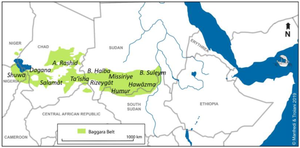This article is written like a personal reflection, personal essay, or argumentative essay that states a Wikipedia editor's personal feelings or presents an original argument about a topic. (November 2024) |
| Hawazma | |
|---|---|
| Ethnicity | Baggara Arab |
| Nisba | Al-Hazimi |
| Location |
|
| Descended from | Juhaynah of the Hejaz |
| Branches | Abd al Ali, Halafa, Dar Bkhoot, Dar Neilla |
| Language | Sudanese Arabic |
| Religion | Sunni Islam |

Hawazma, part of Sudan's Baggara tribe, are cattle herders who roam the area from the southern parts of North Kurdufan to the southern borders of South Kurdufan, a distance of about 300 kilometers. Through their nomadic movement, the Hawazma know the area, terrain, ethnic groups, local tribes, tribal cultures, ecosystems, climate, vegetation, existence of risks and diseases, and water resources better than any other inhabitants of the region. The term Baggara is a collective name applied to all cattle-herding tribes with Arab roots. Cattle herders from Nuba tribes are not called Baggara. Cattle herders of middle and eastern Sudan, although they are Arab in roots, are also not Baggara. The Baggara occupy a wide area, from Kordofan, Mid-Western Sudan, to Darfur in the far Western Sudan and extending to neighboring Chad. They are a collection of seven major tribes: Hawazma, Messiria Humr Messiria Zurug, Rizeigat, Ta’isha, Habbaniya, Beni Halba, Awlad Himayd, and Beni Selam. All Baggara have similar physical facial features, costumes, dance, religion, food, and in general a common culture and way of life.
